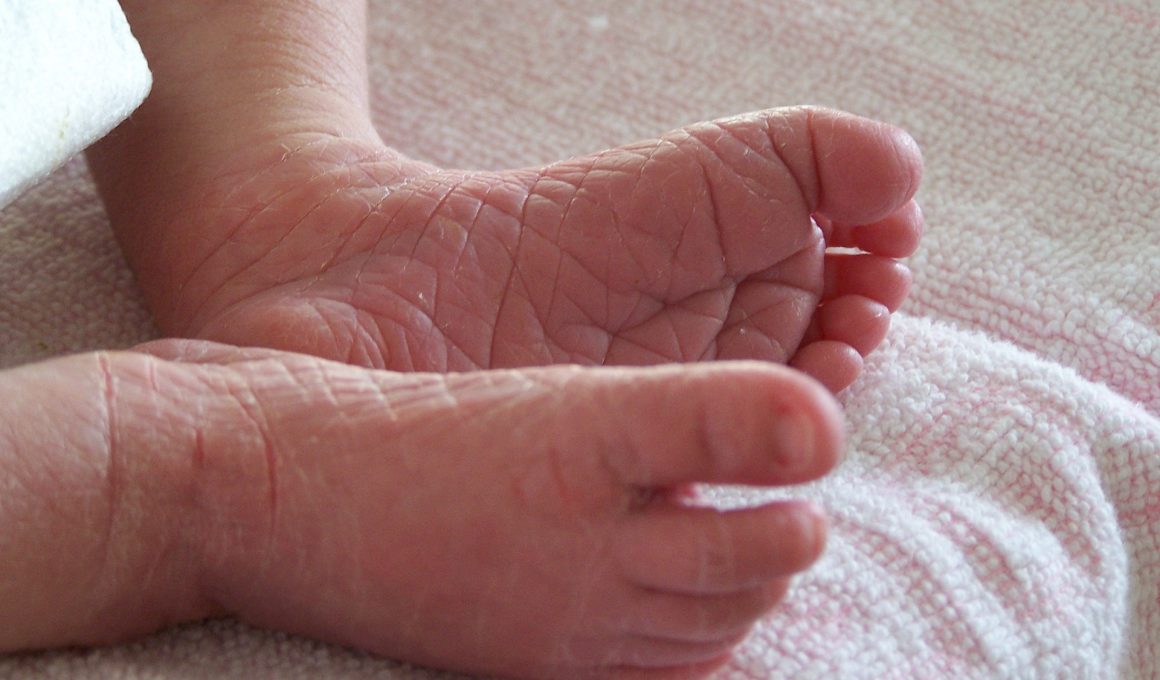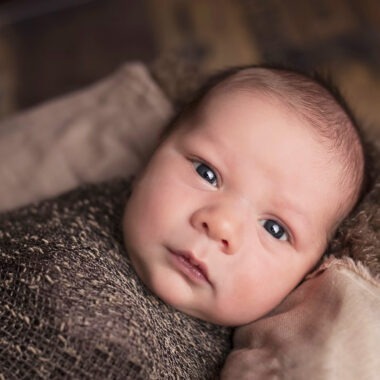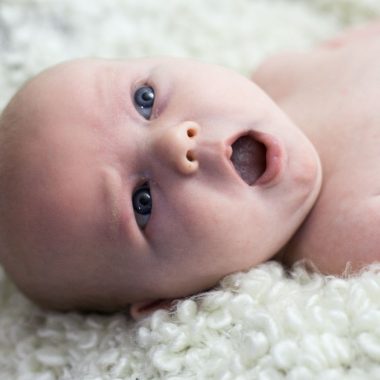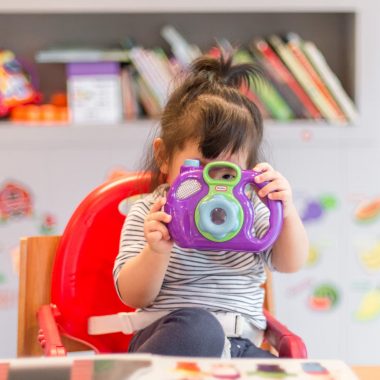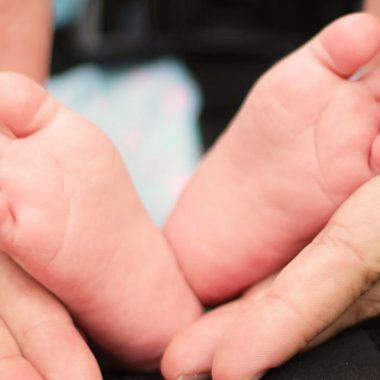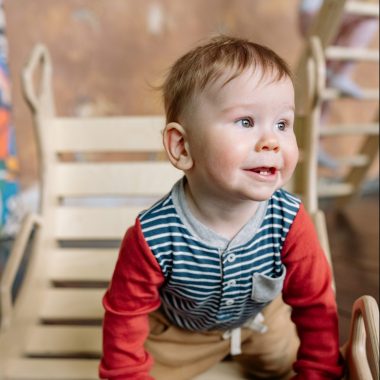When a baby is born, their skin is not structurally complete. It may take between 2 to 4 years to develop fully. And there are consequences to this condition.
For instance, your baby’s outermost layer of skin is thinner than an adult’s. That makes baby skin sensitive and more prone to moisture loss which might result in dry skin.
Dry skin in babies usually goes away without any medication unless there is an underlying medical condition. Besides, appropriate skin care along with preventive measures is always essential.
Most babies have dry, peeling skin right after birth. It is entirely normal as your baby’s skin adjusts to the change in environment from the womb to the real world.
Dry skin in babies may occur at any time, especially during the winter months.
Let’s talk more about the symptoms and causes of dry skin and tips for keeping dry skin at bay.
What Are The Symptoms of Dry Skin On Your Baby?
Some of the more obvious symptoms of dry skin in babies are:
- Dry red patches
- Roughness
- Scaling or flaking
- Peeling
- Irritation
- Sensitiveness to touch
- Fine to deep cracks on the skin
Symptoms of dry skin can make it easy to identify the causes of the problem. However, there may be a wide range of causes to look out for, from simpler daily skin care issues to more serious medical conditions.
What Causes Dry Skin In Babies?
Basically, dry skin in babies is caused by loss of moisture.
Factors that lead to this are:
Weather
Extreme heat or cold can drop humidity levels, making your baby’s skin lose moisture and dry out. This means dry skin can get worse in both summer and winter.
Cracked skin from exposure to cold and wind is common in winter.
Some simple skin care tips to remember for any season are:
- Always be sure to dress your baby in appropriate clothing for the season.
- To protect your baby from sun, wind, and rain, use hats, gloves, and shades or covers on your baby’s stroller.
- Keep your baby out of direct sunlight.
- Apply appropriate sun lotions on your baby’s skin in summer.
- Use appropriate moisturizers and lip balms in winter.
Environmental Temperature
Hot air or hot water can dehydrate the skin just as cold air does.
Heat removes humidity in the air and dries out the skin.
If the central heating system of the house is set to a high temperature, the air in the house will gradually lose its moisture and as a result, dry out your baby’s skin.
Hot baths can dry your baby’s skin as well.
Dehydration
Babies need to stay hydrated. You must ensure that your baby is drinking enough milk or formula.
In the case of newborns, breast milk is the best solution to keep them hydrated. The World Health Organization (WHO) recommends breastfeeding up until six months of age, starting from birth.
Cool air, if dry, can also dehydrate your baby’s skin. Using a humidifier in the house to regulate indoor moisture may be helpful.
Overexposure to water
Too much water can have adverse effects on your baby’s skin.
Although it’s important to keep your baby’s skin clean, spending too much time in the water is unnecessary as it can dry out your baby’s skin.
Long baths can wash away the natural protective oils from your baby’s skin, making them vulnerable to external factors.
Bathing your baby in chemically-treated or chlorinated water can also dry out their skin.
Soaps and lotions
A baby’s skin is thinner and doesn’t have the same protective barrier as an older child or adult.
Hence, using standard soaps and shampoos for your baby will irritate their skin.
Alcohol-based products are also harmful as they strip moisture from the skin by removing natural oils.
Always read the label of any products you use for your baby e.g. bath soaps, lotions, or detergents.
Always buy products that are formulated for sensitive baby skin.
Genetic Factors
Skin problems that parents face can also be genetically transferred to their babies. If the mother and father have dry skin problems, their baby may also have the same problem.
Medicines
Some types of medicines may have adverse effects on the skin. These medications reduce moisture levels in the skin, resulting in dry skin.
If you are taking medications and breastfeeding, your baby could be affected. Make sure that any medication you take is safe to consume while breastfeeding.
Newborn Skin Peeling
It is common for newborn babies’ skin to peel. Generally, this doesn’t require any treatment and the condition disappears on its own.
The amount of peeling depends on whether the baby is born pre-term, full-term, or post-term.
Let’s look at some facts about newborn skin peeling:
- In the womb, amniotic fluid surrounds the fetus. The fetus’ skin in the womb is protected from the amniotic fluid by vernix caseosa. The skin would dry out and wrinkle if it were in direct contact with the amniotic fluid. Vernix caseosa is a creamy, cheese-like substance that is a barrier for the baby.
- After birth, vernix caseosa is wiped off the baby’s skin with other fluids (mother’s blood and amniotic fluid).
- Once that happens, you may notice your baby’s skin has already begun to flake. This is more common in babies born after 40 weeks.
- The amount of peeling depends on whether the baby was born pre-term, full-term, or post-term. Premature babies have more vernix caseosa and experience lesser skin peeling. The more vernix caseosa a baby is born with, the less their skin will peel later on.
- Post-term babies often have less vernix caseosa but experience more skin peeling than babies born at full-term.
- Leaving the vernix caseosa on the baby’s skin for a while after birth may help the baby’s skin adapt to its new environment.
- Skin peeling is a natural process; most babies do not need medical treatment. It goes away on its own.
- While a newborn’s exposure to amniotic fluid is the most common cause of newborn skin peeling, there may be other possible causes, such as atopic dermatitis or other types of eczema, psoriasis, and ichthyosis.
Newborn Skin Peeling Treatments
Experts do not recommend additional treatments or moisturizers for newborn babies during the first month of life. Newborn skin peeling is normal and must be expected.
But if you’d like to do anything additional, contact your pediatrician first.
Here are some home remedies you can add to your newborn’s skincare routine:
Short bath time
Keeping your baby’s bath time under 10 minutes is advised.
- Avoid daily baths if possible.
- A sponge bath is recommended until the umbilical cord falls off.
- Hot baths cause further dryness. Keep water lukewarm but not hot.
Avoid using soap
Ordinary soaps shouldn’t be used for your newborn. They will strip your baby’s skin’s natural oils and cause excessive dryness. Baby soaps are milder.
Remember that even when using baby soaps, avoid using them on a daily basis.
Use a humidifier
Heat can remove humidity in the air and dry out the skin. You should maintain a certain level of humidity in your baby’s room.
Using a humidifier might be a good choice.
It is recommended to keep your baby’s nursery humidity levels between 50 and 60 percent.
Use cotton clothing
Always dress your baby in cotton clothes.
Cotton is the most highly recommended material for wear. It is soft and allows the skin to breathe.
What Might Happen to Baby Skin During Winter?
As baby skin is more sensitive, it is more susceptible to moisture loss. During the winter season, your baby’s skin can dry out quite quickly.
Below are some skin conditions you may notice in your baby during winter.
Chapped lips
Dry lips are a common problem for babies. You can use a lip balm made with safe ingredients for your baby.
If breastfeeding, you can apply breast milk to your baby’s lips.
Red cheeks
When exposed to the cold, your baby’s cheeks may quickly get irritated. The wind affects your baby’s skin the most.
Moisturize your baby’s face by using appropriate products before and after going outside.
Keep your baby safe from the wind with a hat and cover for the stroller.
Dry, itchy skin
Dry winter air causes your baby’s skin to lose moisture and dry out.
Dry skin can cause itchy patches all over the body. These can irritate the baby. Please seek help from your pediatrician. Ask for solutions to protect your baby’s skin.
Skin Problems That Cause Dry Skin
Dry skin problems may be the result of some skin conditions or problems.
Some of these conditions are:
Cradle cap
Cradle cap is a common condition among babies aged a few weeks old to 12 months.
In cradle cap, either an overproduction of oil or a bacterial infection of the hair follicles results in a build-up of dead skin. This results in crusty or oily scaly patches on your baby’s scalp.
Cradle cap affects your baby’s scalp and upper face, including brows, eyelids, and the area behind the ears.
Never pick at the scales or flakes, as this will only worsen and increase the risk of infection.
Cradle cap can clear up and reoccur for several months, but it generally goes away when your baby is around 8 months old.
Eczema
Eczema or atopic dermatitis can cause your baby’s skin to dry out and peel.
Characterized by a dry rash on the face, elbows, and knees, it is an allergic skin condition, and the itchiness may lead to skin peeling.
This condition rarely develops right after birth but may appear later in infancy. Its exact cause is unknown. Several factors can trigger a flare-up, including exposure to irritants such as shampoos and detergents.
By eliminating known triggers and regularly applying emollients to maintain moisture, eczema can be avoided.
Ichthyosis
Ichthyosis is a less common genetic condition that causes severely dry skin.
Only your baby’s doctor can diagnose ichthyosis with the help of a physical examination and studying the family’s medical history.
This condition can start to appear at 2 months and can affect most areas of the body.
There’s no cure for ichthyosis, but regular creams can relieve dryness and improve the skin’s condition.
Keratosis pilaris
Keratosis pilaris is a genetic condition where the skin produces an excessive amount of a protein called keratin.
This blocks glands in the skin resulting in tiny raised bumps that make the skin feel dry and rough.
The bumps are mostly seen on the arms, legs, and buttocks. It’s sometimes referred to as ‘chicken skin’ because of its bumpy appearance.
Keratosis pilaris is harmless and has no adverse effects on a baby’s health.
Using moisturizing creams can soothe itchiness and reduce dryness and redness.
Pityriasis alba
Pityriasis alba is a type of eczema. It affects the face, arms, and torso. It is characterized by dry and scaly lesions that may become red with time.
You can treat the dryness and itchiness caused by pityriasis alba with moisturizing creams, and by avoiding regular soaps and shampoos.
Psoriasis
Psoriasis is an autoimmune disease that causes an overgrowth and build-up of skin cells.
This results in reddish-white scaly patches on the skin, which sometimes appear silver.
These lesions can occur on the scalp, face, neck, trunk, nappy area, and elbow or knee folds.
Though psoriasis is a common condition in children and young adults, it’s less common in babies. It can be harder to diagnose early due to its similarity with other dry skin conditions.
Like eczema, psoriasis can come and go over time and is triggered by environmental factors.
You can treat psoriasis similarly to eczema by avoiding triggers and maintaining skin moisture.
What’s The Difference Between Dry Skin And Eczema In Babies?
Dry skin and eczema can have common symptoms. And it’s hard to distinguish between them.
However, some important points to remember are:
- Eczema can lead to dry skin.
- Dry skin may resemble eczema.
- Their symptoms may be shared.
- Only an expert may distinguish between the two.
- In general, eczema is seen among babies who have a family history of eczema.
- Dry skin problems may lead to dry red patches. But in eczema, inflammation might occur, especially during flare-ups.
- Weather conditions trigger both dry skin and eczema. But eczema may also be triggered by moisture (sweat, saliva, and even milk), dust, and soaps and detergents.
- The effects of eczema may vary in every baby.
How To Prevent Dry Skin In Babies
Using simple tips may be enough to prevent dry skin in babies if there are no underlying medical problems.
In general,
- Keep your baby away from cold indoor and outdoor conditions.
- Use a humidifier in your baby’s room.
- Maintain a bath time of 10 minutes at max.
- Avoid using heavily scented lotions and perfumes around your baby.
- Only use baby-friendly products if you need to use a moisturizer on your baby’s skin.
- Avoid vigorously rubbing your baby’s skin while cleaning or bathing.
How To Treat Dry Skin In Babies
Sometimes treating dry skin in babies does not require any medication. Changing a few things in your baby’s environment could fix the issue entirely.
Reduce exposure to cold air
Skin exposed to cold, dry air is more prone to dryness. Hence, reducing your baby’s exposure to cold air may prevent dry skin problems.
Before going out, layer up your baby with a hat and mittens and apply an ointment or balm to their cheeks and lips.
Keep your baby hydrated
Keeping your baby hydrated is another way to treat dry skin. Make sure your baby gets enough water from breast milk or formula.
Breast milk or formula would be sufficient to hydrate babies up to 6 months of age.
Adjust indoor air
Hot air tends to be dry. During winter, heating systems reduce water vapor levels in the air, leading to dry skin conditions.
Using a humidifier, especially in your baby’s room, is an excellent way to prevent dry skin. A humidifier will increase the amount of moisture in the room.
Lukewarm water
Lukewarm water is ideal for washing and cleaning your baby’s skin. Fill the tub with lukewarm water instead of hot water.
Hot water tends to dry out the skin far more. It might also help to apply moisturizer immediately after a lukewarm bath.
When it’s time to towel off, gently pat your baby’s skin to dry instead of rubbing it.
Moisturize your baby’s skin
You can buy moisturizers that are particularly suitable for a baby’s sensitive skin,
In fact, avoid using products formulated for adults.
Avoid contact with chemicals
Baby skin is very sensitive. If it comes into contact with chemicals like perfumes or scented soaps, it can easily become irritated.
Be careful with using chemicals and keep them away from your baby’s skin.
Choose appropriate clothes
Cotton clothes and natural fabrics are ideal for any baby’s sensitive skin. They are lightweight and allow the skin to breathe.
Also, soft, loose-fitting clothes made of natural materials are less likely to irritate your baby’s skin.
Be on drool alert
Excess moisture from saliva or a runny nose can lead to chapped skin. Keep some cotton pads or wipes handy to dab away at the dribble.
Keep your baby comfortable
Most parents forget that treating your baby’s peeling skin problems involves keeping your baby as comfortable as possible.
This may involve soothing them and helping them find positions that avoid putting pressure on the affected areas.
Try an oatmeal bath
Research shows that colloidal oatmeal (finely ground oatmeal) reduces inflammation and itching.
Oatmeal bath treatments are available in many drug stores, natural food stores, and even online.
References: medicalnewstoday.com, whattoexpect.com, healthline.com, parents.com, webmd.com, mayoclinic.org


